【ロサンゼルス校の講師が英訳】アジア系公民権運動のリーダー日系一世 藤井整の伝記『A Rebel’s Outcry(英題)』が出版(前編)
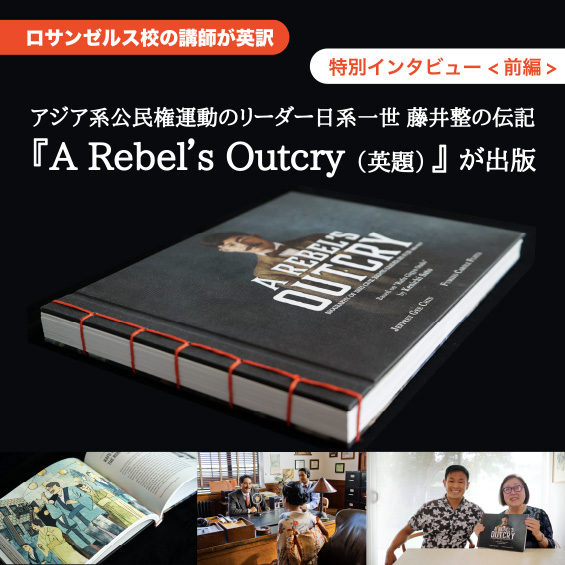
公民権運動と聞くとキング牧師や“I have a dream”演説が有名だが、アジア系コミュニティでも差別と戦い、権利を勝ち取ってきた歴史がある。日系一世と呼ばれる日本からの移民は、多民族社会が成り立つ前のアメリカで、差別や偏見と向き合いながら自分たちのコミュニティを築いてきた。彼らは第二次世界大戦中には、強制収容所に収容され、戦後も激しい差別と闘いながら一からの立て直しを経験する。
When most people think about the civil rights movement in the US, Martin Luther King, Jr. and the “I Have a Dream” speech are usually top of mind. However, in Asian American history, people also had to fight against discrimination to have their rights acknowledged. Before America became a diverse society, many first-generation Japanese Americans, or issei, struggled to build their communities due to discrimination. They were even removed from their homes and incarcerated in internment camps during World War II. After the war, they had to rebuild their lives from the beginning, and still faced harsh discrimination.
日系アメリカ人の歴史を語る上では欠かせない日系一世、藤井整の伝記『羅府ぎぎゅう音頭- 排日土地法を葬った藤井整の記録』の英訳版書籍“A Rebel’s Outcry”が2021年11月に出版された。英訳を、ロサンゼルス校で実務翻訳クラスの講師を務める比嘉・ディッキンソン・佐恵子さんが手掛けている。
In the history of Japanese Americans, it is impossible to omit Sei Fujii. His biography, ” A Rebel’s Outcry”, will be released in November 2021. Saeko Higa Dickinson, who teaches at JVTA Los Angeles, translated the book into English.
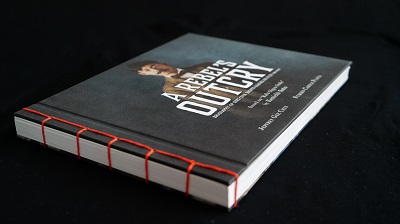
藤井整は、1882年に山口県で生まれ、1903年に南カリフォルニア大学の留学生として渡米。ロースクールを卒業するものの、当時のアメリカではモンゴロイドにあたる移民は市民権を取得できず、弁護士資格を得ることもできなかった。1931年に、日系一世のための日本語新聞を刊行する加州毎日新聞を設立。さらに、日系人の土地の所有権を勝ち取り、日系病院の設立に尽力するなど日系コミュニティに偉大な功績を残した。藤井の死後63年後の2017年にカリフォルニア州最高裁判所は藤井の弁護士資格を認めるという判決を下す。当人の死後に弁護士資格が認められるのは異例の出来事だった。
Fujii was born in Yamaguchi Prefecture in Southern Japan in 1882. In 1903, he came to the United States as an international student at the University of Southern California and graduated from Law School there. However, those archaically defined as “Mongolian race” were prohibited from receiving law licenses, so he was unable to become a lawyer. In 1931, he established a newspaper for the Japanese American community, called The Japan California Daily News. Moreover, he contributed to the Japanese immigrant community by fighting for their rights to purchase land and establish hospitals in Los Angeles. In 2017, sixty-three years after his death, the California Supreme Court unanimously granting Fujii a posthumous law license.
2012年に、藤井整を描いた短編映画『Lil Tokyo Reporter』が公開された。監督を務めたのは中国系アメリカ人三世のジェフリー・チン氏。2021年11月に出版された書籍の英訳版制作にはプロデューサーとして関わっている。
In 2012, a short film titled “Lil Tokyo Reporter” about Sei Fujii was released. It was directed by Jeffrey Gee Chin, a Chinese American director. He is also a producer of the translation and adapted publication of “A Rebel’s Outcry”.
◆『Lil Tokyo Reporter』予告編はこちら
映画監督で本のプロデューサーであるジェフリー・チン監督と翻訳者の比嘉・ディッキンソン・佐恵子さんに、日系人の歴史や書籍の英訳プロジェクトについてお話を伺うことができた。記事の前編では、アジア系移民の歴史に興味を持ったきっかけや短編映画『Lil Tokyo Reporter』の制作についてチン監督のお話を紹介する。後編では、翻訳者のディッキンソンさんに書籍の翻訳について詳しく伺う。
JVTA had an interview with Jeffrey and Saeko about the history of Japanese Americans, the story behind adopting the book project, and more. During Part 1 of the interview, Jeffrey talks about how he became interested in Asian immigrant history and the background of making “Lil Tokyo Reporter.” Part 2 includes the interview with Saeko who talks about translating the book.
JVTA アジア系移民について興味を持ったきっかけを教えてください。
JVTA: How did you become interested in Asian immigrants?
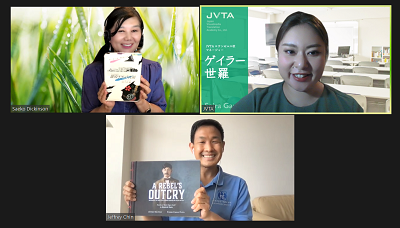
チン監督 私自身は中国系アメリカ人三世で、北カリフォルニアにあるマリーン郡の白人コミュニティで育ちました。中国南部からの移民で、ニューヨークに住む祖父母を訪ねることもあり、一世にあたる彼らから、移民としての経験談を聞く機会がありました。自身のアイデンティティである中国系アメリカ人の歴史が消えてほしくないという思いもあり、アジア系移民の歴史や彼らの経験を記録に残したいと感じるようになったのです。その後は、1800 年代のゴールドラッシュに中国系移民がコミュニティを築き、エビ釣り漁が盛んだったことで知られるチャイナ・キャンプ・ステート・パークに関わったり、自身のルーツがある中国を訪れたりしました。アジア系アメリカ人として自身のルーツを知ること、彼らを知ってもらう活動は、自分自身のアイデンティティのためだけではなく、アジア系にルーツを持つ方々をエンパワメントすること、さらに歴史を築いてきた先駆者から次の世代までを守ることに繋がります。さらに、より多くの人にアジア系移民の歴史について知ってもらうことで、私たちが“よそ者”ではなく、“アメリカ市民“であるという理解を深めることができるとも思います。特に今の時代にとても重要なことです。
Jeffrey: I’m 3rd generation Chinese American. I grew up in Marin County, Northern California in what was a predominantly white neighborhood. I also spent time in New York with my grandparents who came from Southern China. I heard their stories of their immigrant experience and journey to America, and felt a need to document their history. I feared that if I did not preserve their stories, my own identity would start to fade. I started getting interested in working with China Camp State Park, where Asian immigrants did shrimp fishing in the late 1800s after the Gold Rush. I even visited my family’s ancestral villages in China. Through these experiences, I gained an appreciation of learning about our past. I feel the power of doing research and telling stories of Asian Americans is empowering, not just for my own identity, but it helps protect the next generation, and even our grandparent’s generation. The more people understand and appreciate the nuance of who we are as a community, the more people will be able to think of us as peers and as fellow Americans rather than perpetual foreigners. And I think that is very important, especially now.
JVTA なぜ藤井整と日系人の歴史を描いた短編映画『Lil Tokyo Reporter』を作ろうと思ったのですか?
JVTA: How did you know about Sei Fujii? Why did you make the short film about him and Japanese American’s history?
チン監督 サンフランシスコのジャパンタウンで開催されたthe First National Asian Pacific Islander Historic Preservation Forumに参加した時に、リトル東京歴史協会の創始者であるビル・ワタナベ氏と、創設メンバーのキャロル藤田氏に会いました。藤田氏から、南カリフォルニアで初めて日系人によって設立された病院の歴史についての話を聞き、興味を持ちました。しかし、同時に、日系人の歴史に若者の関心を引くことは、難しいと思ったのです。そこで、歴史をドラマ仕立てのストーリーにして、登場人物に共感してもらうことで、日系アメリカ人やアジア系アメリカ人についてより理解が深まるのではないかと考えました。
Jeffrey: I had attended the First National Asian Pacific Islander Historic Preservation Forum in San Francisco’s Japan Town. I met Bill Watanabe who is a founder of the Little Tokyo Historical Society, and Fumiko Carole Fujita who is also a founding member. She talked about the history of the first official Japanese Hospital in Southern California and a pioneer who helped build it. I was intrigued, but I also felt that sharing the story would be difficult to retain the attention of the average young person without providing enough context and history. I thought that if I could convert the story into a drama, and they can enjoy the characters in the world, they would start learning and appreciating more the Japanese American/Asian American experiences.
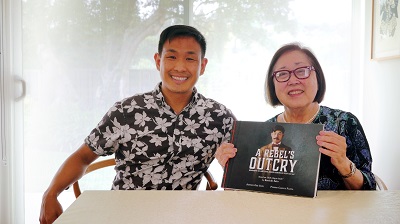
※チン監督とキャロル藤田プロデューサー
JVTA 『Lil Tokyo Reporter』は初監督作品でしたが、特に印象に残っている思い出は何ですか?
JVTA: Was there anything particularly memorable about directing your first film, “Lil Tokyo Reporter,” as executive director?
チン監督 多くの年配の日系アメリカ人の方々にエキストラとして参加していただいたこと、そして、アカデミー賞最優秀短編映画賞を受賞した『ビザと美徳』で監督と俳優を務めたクリス・タシマや、『硫黄島からの手紙』にも出演した尾崎英二郎や安東生馬など著名な日系の俳優に出演していただいたことです。
Jeffrey: One of the wonderful experiences was that we got to bring in a lot of older Japanese Americans and place them into the scenes as extras, and even actors like Chris Tashima from “Visas and Virtue” which he won the Academy Award for Live Action Short Film, and Eijiro Ozaki and Ikuma Ando from “Letters from Iwo Jima.”
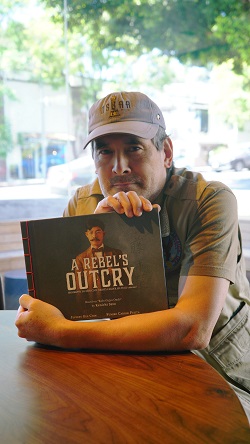
※クリス・タシマ氏
JVTA 中国系アメリカ人として日系人の歴史を映画にすることの難しさはありましたか?
JVTA: Did you face any difficulties as a Chinese American making films about Japanese American history?
チン監督 私自身は日系アメリカ人ではないので、日系コミュニティにとってよそ者ですが、私の祖父母の世代が経験したようなアジア人が差別を受けたという過去に共通点があります。多くの人はアジア人を一括りに捉えています。しかし、アジア人の中でもそれぞれ人種の違いがある。それを知ってもらうことは、アジア系コミュニティへの貢献になると思いました。実は、映画の制作中に一部の方々から批判を受けるなどさまざまな試練がありました。しかし、そんな中でも2人の人物が私を擁護してくれたんです。批判した人たちは、私が日系アメリカ人ではないことに疑問があったようです。私を支持してくれた方の一人は、“論より証拠”つまり、完成物を見れば実力がわかると…。ただ、こちらに情熱があったので、最終的には批判した人たちも私を信用してくれましたね。その後もリトル東京歴史協会の役員に選んでいただき、日系アメリカ人のための活動を続けることができています。
Jeffrey: I’m an outsider. I’m not Japanese American. But I can relate because my grandparent’s generation had gone through similar experiences, like discrimination against the Asian community. When people see Asian Americans, they don’t see the difference between us. I thought that if I do a great job, representing each and every one of our communities, I can help us along the way. Also, there were two people who really stood up for me when we were really fighting and being challenged with things. One said, “The proof is in the pudding,” meaning that you will know the result in the end product. A question was that I’m not Japanese American. But I’m passionate. So they ended up supporting me, and ever since then I’ve been so blessed and lucky to continue working with the Little Tokyo Historical Society and to be a board member. And that’s just been a wonderful path.
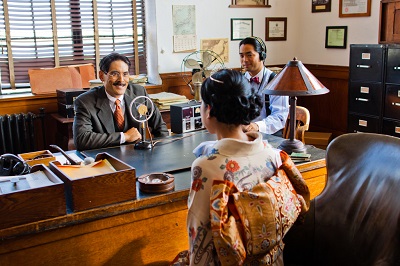
※『Lil Tokyo Reporter』より
JVTA 『Lil Tokyo Reporter』の公開後も精力的に日系コミュニティへの貢献や藤井整についてリサーチを続けたそうですね。活動について教えてください。
JVTA: Since “Lil Tokyo Reporter” came out, you have contributed to the Japanese American community, and also continue researching about Sei Fujii. Could you tell me more about that?
チン監督 映画の公開後も藤井整についていくつかのプロジェクトを手掛けました。リトル東京に藤井の顕彰碑の建立、藤井が日系人医師の権利のために戦った日系病院の史跡指定などが挙げられます。また、シドニー・カナザワと日系弁護士会により、藤井の死後に彼の弁護士資格を得ることもできました。
Jeffrey: After we finished the film, we had continued publicity and our organization was able to do several projects, including a memorial lantern built in Little Tokyo, the historic designation of the Japanese Hospital in Boyle Heights where Sei Fujii helped represent a group of Japanese doctors, and the award of a posthumous law license to Sei Fujii, which was a big effort led by Sidney Kanazawa and the Japanese American Bar Association.
JVTA 藤井整の伝記『羅府ぎぎゅう音頭- 排日土地法を葬った藤井整の記録』の英訳を出版するまでの経緯を教えてください。
JVTA: Could you tell me what the process was like to adapt the book?
チン監督 藤井整関連のプロジェクトを手掛けている間にリサーチも続けました。1983年に出版された藤井整の伝記『羅府ぎぎゅう音頭- 排日土地法を葬った藤井整の記録』(著作・佐藤健一)に出会ったのは2010年。翻訳者のディッキンソンさんとは、リトル東京サービスセンターとリトル東京歴史協会の創始者であるビル渡辺氏を通して知り合いました。当初は、2年の予定が、結局は10年かかりました。藤井は、アジア系公民権運動の偉大な指導者というだけでなく、彼自身が、日系一世全体を投影しています。当時の日系コミュニティには、他者にどう思われようが恐れないこと、人権問題に立ち向かう姿勢があったからです。
Jeffrey: In between all of the projects I mentioned, we were still researching Sei Fujii. Back in 2010, I was first introduced to “Rafu Gigyu Ondo” written and published by Kenichi Sato in 1983. Saeko had been recommended by Bill Watanabe, who is a founder of the Little Tokyo Service Center and the Little Tokyo Historical Society. The book adaptation was supposed to be a two year project, but it ended up turning into a ten year process. It’s not just that Fujii was an incredible civil rights leader, but also that his story represents the whole generation of pioneering Japanese immigrants. The Issei were a fearless group, unafraid of how people thought of them, and were able to pursue their lives despite generations of discrimination.
JVTA 本の制作はいかがでしたか?制作中の思い出や感想を教えてください。
JVTA: How was making the book? Any memories during research about Sei Fujii?
チン監督 『A Rebel’s Outcry(原題)』の制作を通して藤井整に命を吹き込むことができて嬉しく思います。アメリカ国内に藤井整という人物を広めるだけでなく、日本との架け橋を築くことができました。在日米国大使館と在福岡米国領事館と共同で、日系移民についてのプログラムの開催や、オーロラ日本語奨学金基金と山口県岩国市の福田良彦市長の協力を得て、高森町から藤井がアメリカに向けて出航した港まで辿ることもできました。また、現在も藤井家のご実家に住んでいるお孫さんとも繋がることができたのです。藤井が在籍していた高校にも行き、当時の校舎の写真や、卒業アルバムを見ることができました。藤井のルーツを調べたことで、藤井が多くの人に影響を与えていたことが分かりました。『A Rebel’s Outcry(原題)』にはこうして調べた内容も追記されています。世界中の日系コミュニティを支援するためにも、将来的には『A Rebel’s Outcry(原題)』の日本語版を制作できればと思っています。
Jeffrey: I’m honored to breathe life into Sei Fujii’s story through “A Rebel’s Outcry”. Not only have we been able to share Fujii’s story with people in the United States, we have also helped bridge a connection to Japan. We have collaborated with the U.S. Embassy in Tokyo and U.S. Consulate in Fukuoka to host programs in Japanese migration. With the help of the Aurora Foundation and Mayor of Iwakuni city in Yamaguchi Prefecture, Yoshihiko Fukuda, I retraced Fujii’s path from Takamori Village to the historic port where Fujii first departed to America. I also connected with Fujii’s granddaughter who still lives in his ancestral home and visited his high school, where I was able to take a glimpse of vintage photographs of his school and even a year book. All of this research has made me realize that there are so many people that could be inspired by Fujii’s life, that I hope I can share this book in the future in Japanese, to help celebrate the diaspora of the Japanese communities across the globe.
後編では、翻訳者の比嘉・ディッキンソン・佐恵子さんに伺った書籍の英訳プロジェクトの全貌について、さらにチン監督へのインタビューの続きもお届けする。お楽しみに。
In Part 2, the translator of the book, Saeko Higa Dickinson, talks about the translation project and also includes a continuation of Jeffrey’s interview.
“A Rebel’s Outcry”の詳細はこちら
https://www.littletokyohs.org/store/a-rebels-outcry
◆◇◆◇◆◇◆◇◆◇◆◇◆◇◆◇◆◇◆
【映像翻訳にご興味がある方】
◆【2022年4月期開講】
入学をご検討中の方はいますぐ「リモート個別相談」へ(希望者には字幕体験レッスン可)

※詳細・お申し込みは▶こちら
◆映像翻訳をエンタメのロサンゼルスで学びたい方】
ロサンゼルス校のマネージャーによる「リモート留学相談会」
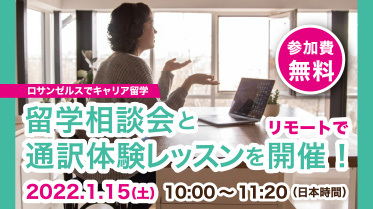
※詳細・お申し込みは▶こちら















